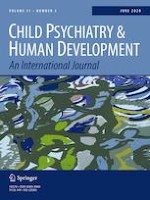25-01-2020 | Original Article
White Matter Tract Integrity, Involvement in Sports, and Depressive Symptoms in Children
Gepubliceerd in: Child Psychiatry & Human Development | Uitgave 3/2020
Log in om toegang te krijgenAbstract
White matter tract integrity, measured via fractional anisotropy (FA), may serve as a mediating variable between exercise and depression. To study this, we examined data from 3973 children participating in the ABCD study. Parents of children completed the Sports and Activities questionnaire and the Child Behavior Checklist, and children completed a diffusion MRI scan, providing information about the FA of the parahippocampal cingulum and fornix. Results showed that involvement in sports was associated with reduced depression in boys. The number of activities and sports that a child was involved in was negatively related to FA of the left fornix but was unrelated to FA of other tracts. FA of these white matter tracts was also unrelated to depressive symptoms. This suggests that while white matter tract integrity is associated with exercise, it may not be part of a pathway linking exercise to depression levels in preadolescent boys.
